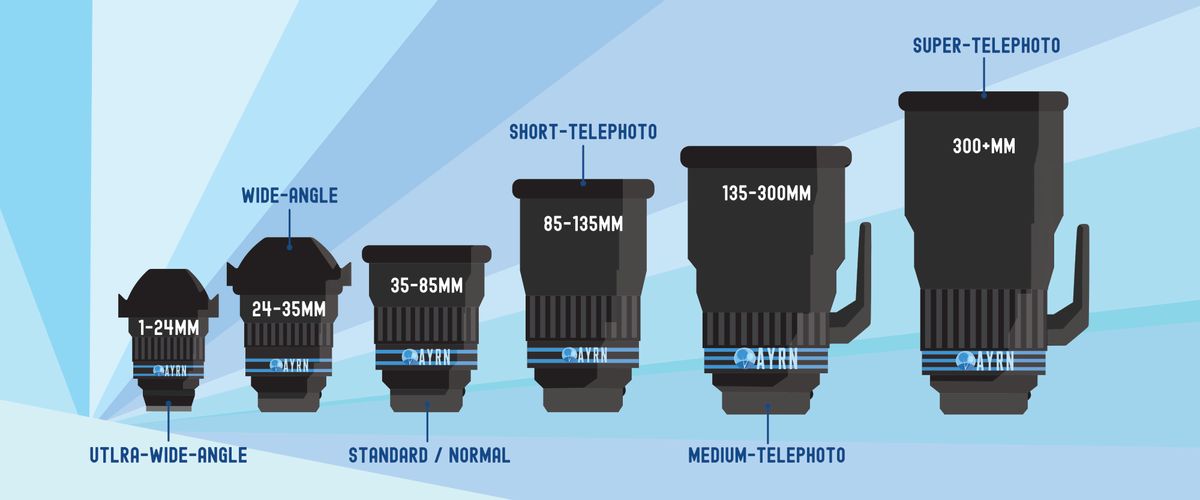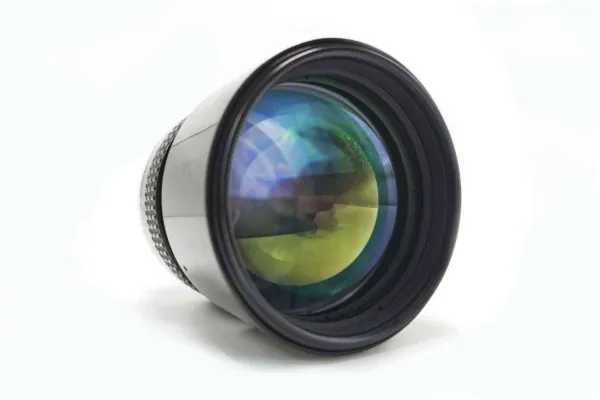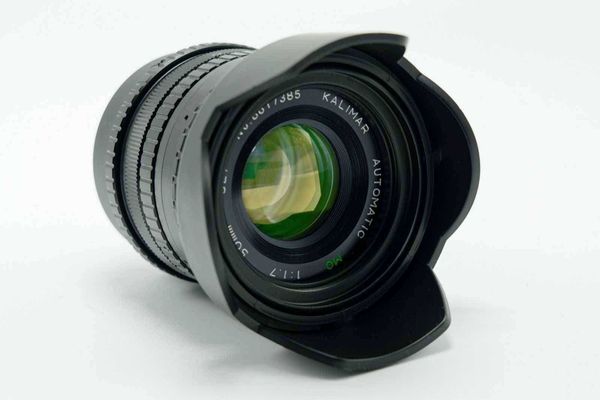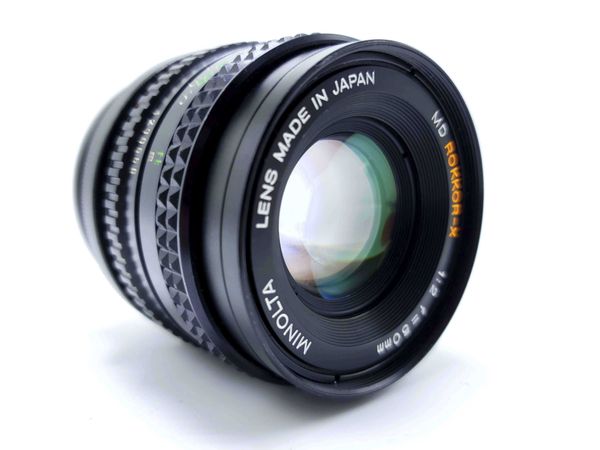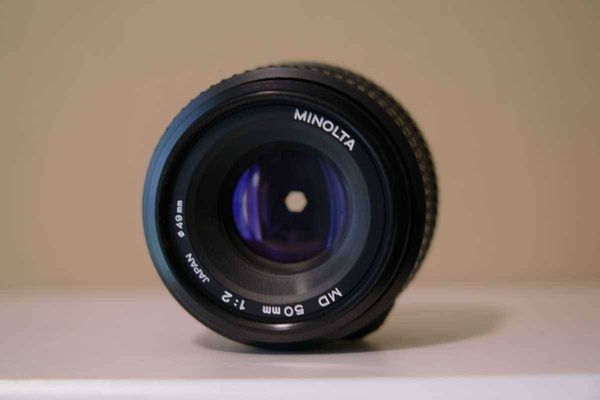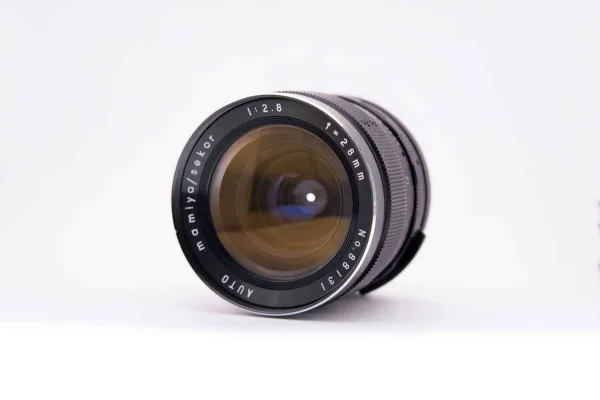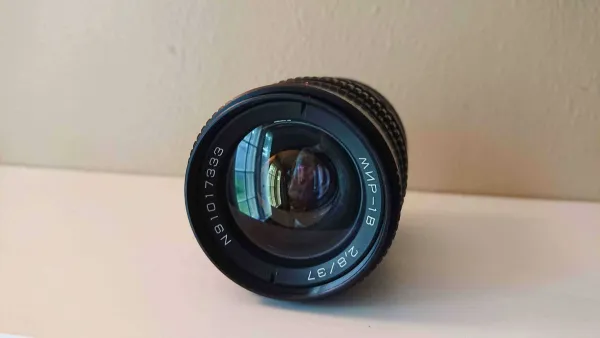Introduction
The first camera was invented over 200 years ago and while many aspects of photography have been standardized and use highly specific terminology, there is a real issue of confusion and disagreement regarding focal length terminology. Improper or ambiguous use cases exist in both retail scenarios and the professional photography community.
Through in depth analysis, the goal of this article is to review high credibility sources and identify accurate terminology for respective focal lengths in full-frame /35mm photography and provide them in the form of a standardized chart as a reference point.
Want to say thanks for an ad-free, subscription free experience and top-notch content?
 Buy
me a coffee
Buy
me a coffeeContents
Focal length is relative to sensor size
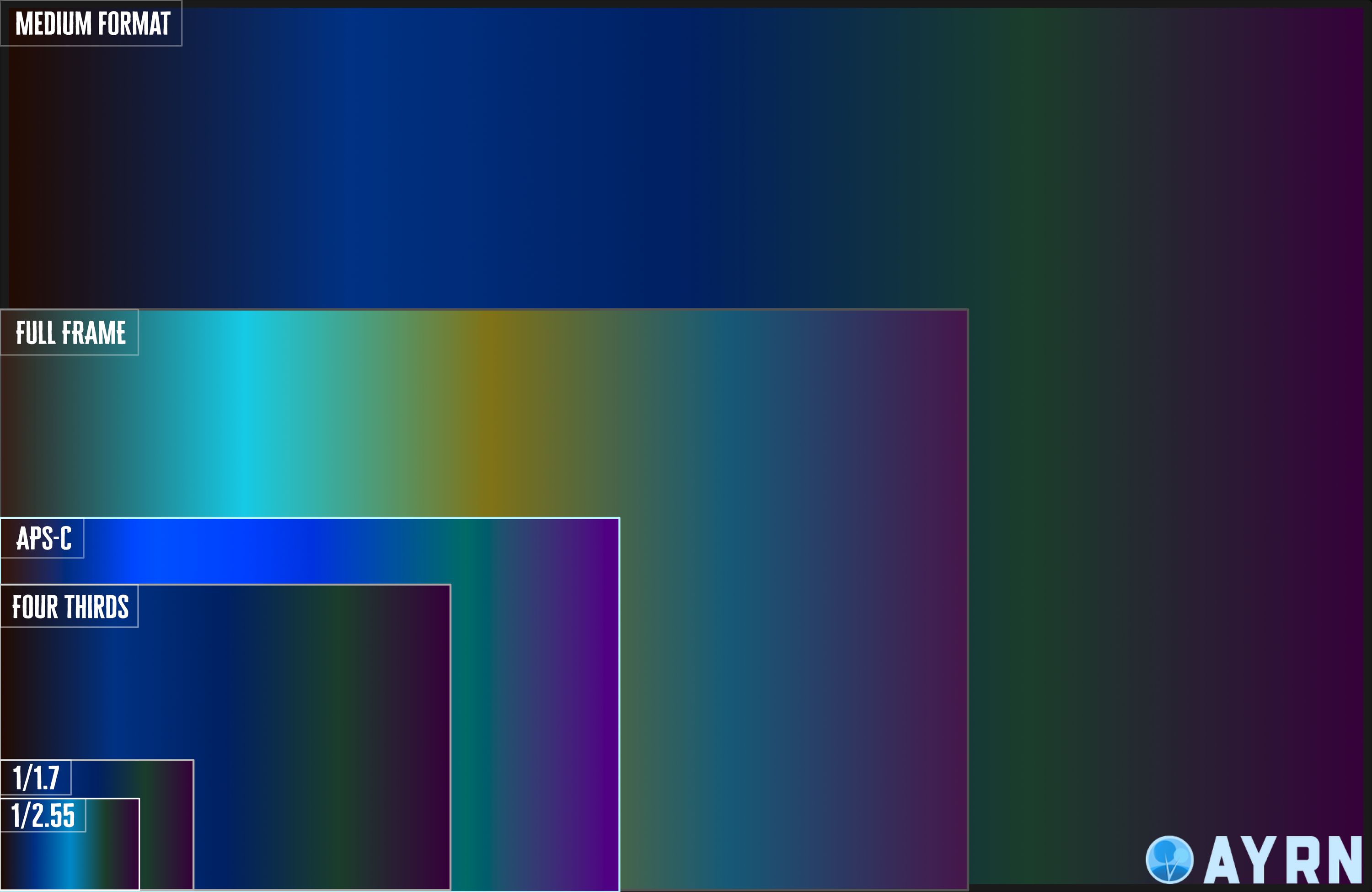
Like many things in photography, focal lengths are a moving target because they're relative to the sensor size. However, to avoid diving too deep down the rabbit hole, I'm going to stick with the established 35mm film format, or in digital camera terms, "full-frame" sensor size. Thanks to the wild popularity of 35mm film back in the day, it's still the universal standard that everything is relative to in the digital world.
By relative, I mean that an 85mm lens for a full-frame or 35mm camera is considered, well...an 85mm lens. That's it. We don't translate it up from medium format to get an equivalent focal length and we don't translate it down from any of the smaller sensor formats as an equivalent focal length.
Now here's where the magic happens - if you take that full-frame 85mm lens and stick it on a camera with a smaller sensor, let's say an APS-C camera-body, you no longer have an 85mm lens, but a roughly 130mm full-frame (or 35mm film) equivalent lens. This is because all smaller sensors can be thought of as a crop of the full frame image. This crop effect is commonly called "crop factor."

To better understand crop factor with smaller sensors and how it works, let's have a look at this 61MP image above that I captured on my full-frame Sony a7rIV. The first image is uncropped, the second image is cropped, the 3rd image is more cropped, and the fourth image is cropped even more still. While not approximate, you can think of this as a representation of the perspective differences between full-frame (1st image), APS-C (2nd image), micro four thirds (3rd image), and a 1-inch sensor (4th image).

I'm not magically making the image larger here, nor would a camera with a sensor that's smaller-than-full-frame in the scenario that we're playing with. What I'm actually doing is making the images smaller every time they appear to "zoom in" by removing more and more of the surrounding scene. Similarly, a smaller image sensor capturing a picture through a full-frame lens is going to give you a narrower field of view - less the parts of the image it can't capture. To simulate this, I have juxtaposed the cropped images over a 61mp backdrop with the same dimensions as the full size image (above).

This also means that the sensor will only capture a fraction the optical surface area of a lens, so you won't get the full perspective that it was designed for (as pictured in my rough approximation above). The takeaway here is that while you certainly can slap a full frame lens on a camera with a smaller sensor, it's still a full-frame lens with a full frame field of view. So while an APS-C system might give you a 130mm viewpoint on our hypothetical example, it's really just an 85mm perspective, cropped. Ergo, the term "crop factor."
Understanding that full-frame is the universal standard by which focal length is determined is important. And while some people might try to claim that they're calling said 85mm full-frame lens "medium-telephoto" because it's longer on an APS-C body camera. It's also worth noting that even if we gave them that, it's still an "I can't believe it's not 130mm on full-frame" perspective, which still falls into the short-telephoto focal range. If we want to follow that sort of thinking to its logical conclusions, I could slap my 85mm full-frame lens on a camera with a tiny 1/2.3 sized sensor and call it super-telephoto, because I'd have an equivalent focal length of 479.4mm. I think you can see the shaky sort of territory that we're getting into with this sort of reasoning.
A historic look at focal length terms
In my research I found that there is an objective historical criteria for focal length terms that is defined not by the field of view or focal length of a lens, but by its optical design. In this sense, there are really just a few types of lens:
- Telephoto
- Reverse telephoto/retrofocus
- Standard
Telephoto
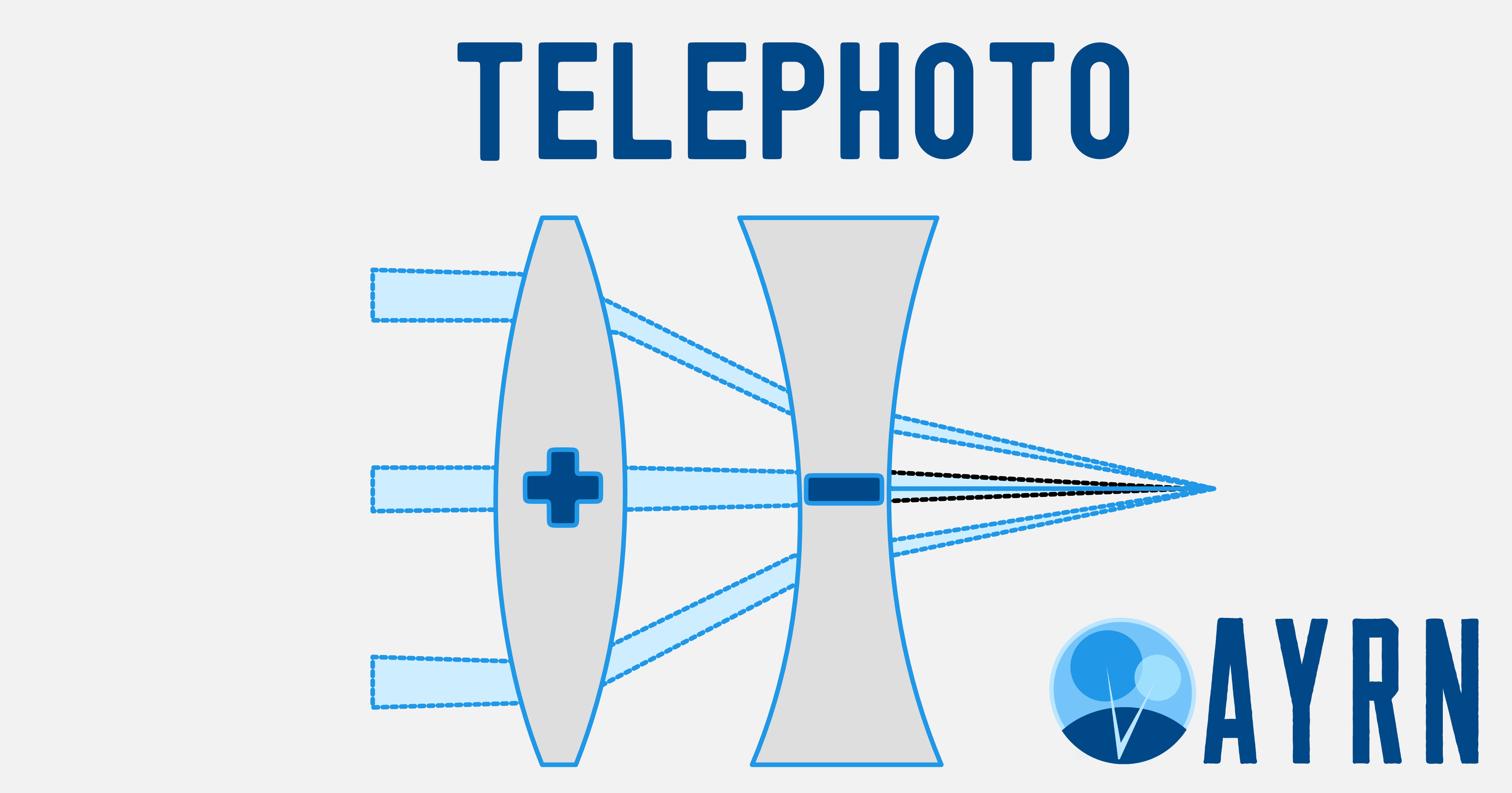
Telephoto lenses are a special type of long-focus lens that was first defined by its use of (surprise, surprise) a once cutting edge telephoto element design. In its most basic form, the telephoto lens design consists of a simple front positive, back negative element formula (as pictured above). This design concept was introduced to long-focus lenses so that they could be made much smaller than they would otherwise be without it. A lens that doesn't have this element design technically isn't a telephoto lens. Most full-frame lenses over 135mm do incorporate telephoto elements, however, many lenses below the 135mm length do not. This means that while many lenses below the 135mm focal length are colloquially referred to as "short-telephoto" or even "medium telephoto," they really aren't telephoto at all in a technical sense.
As an interesting side note, if you've ever wondered what the whole millimeter (mm) thing is about with lenses, that's how long they would be without advances in optical formula technology like telephoto elements. A 600mm lens, for example, would be nearly two feet long - and that's without the lens hood! Imagine carrying that around with you.
Reverse telephoto
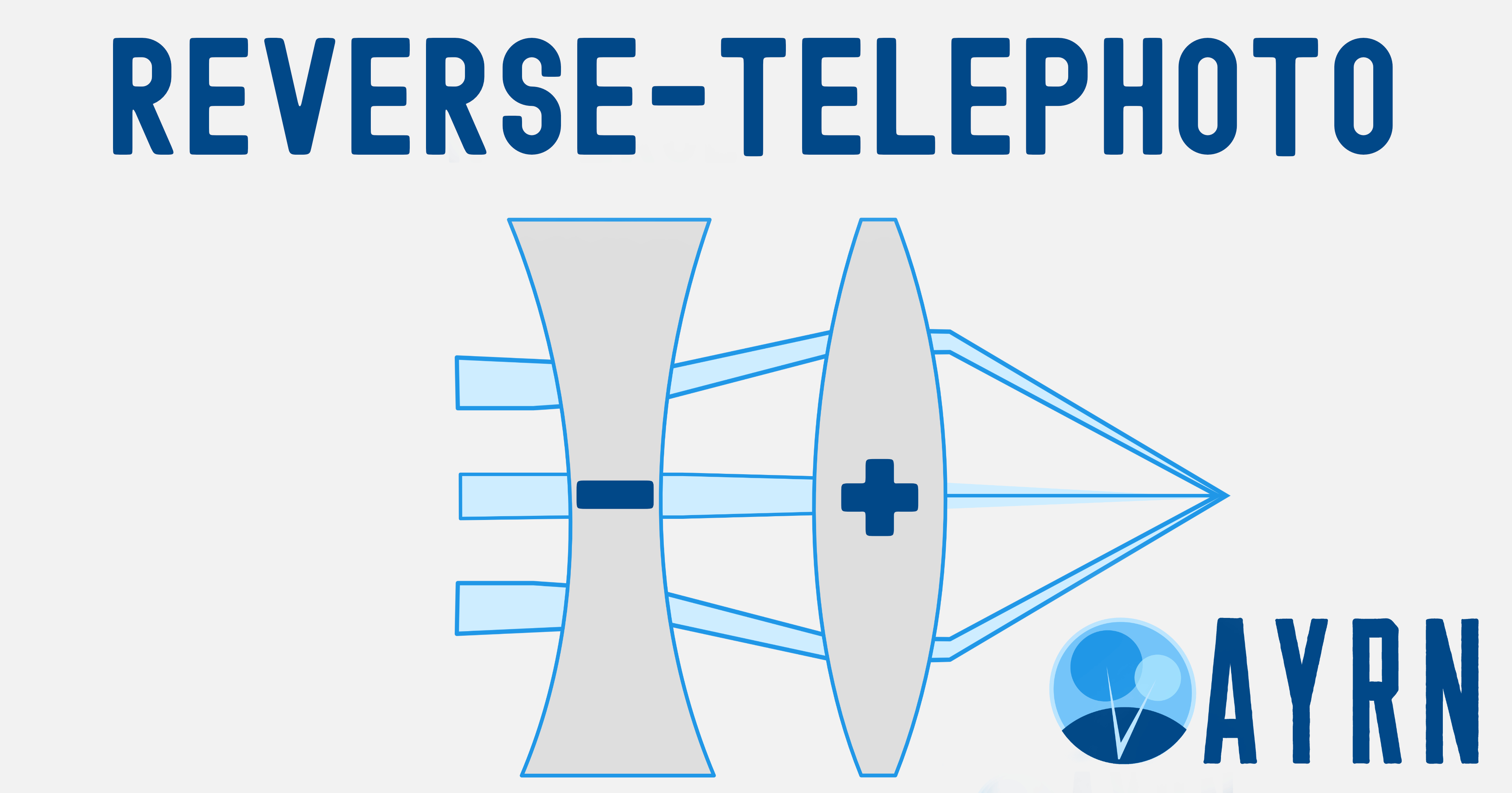
In its simplest form, a reverse telephoto (or retrofocus) lens is just what it sounds like - the reverse of a telephoto lens design. The negative lens element is placed in the front and the positive element is placed in the back this time. This sort of design allows for a much wider field of view than would be possible otherwise and it's still very much alive and well in what most photographers now call a "wide angle" or "ultra-wide-angle" lens.
Prior to the widespread adoption of the reverse-telephoto design, wide-angle photography was pretty rare because it required installing a massive honking beam splitter behind your camera in order to capture a wide angle of view. One of the first popular instances of a wide-angle lens that used the reverse-telephoto design was made by Pierre Angénieux and had an equivalent focal length of 35mm with a 65° angle of view. Angénieux called his new lens the "Retrofocus."
Standard
Standard is a tricky one, and it's often lumped in with the term "normal" to mean a field of view that mimics what you see with your unaided eyes. Scientifically speaking, this equates to an angle of view of about 53°. The prevailing opinion is that 50mm will get you closest to this angle of view, but in reality, the nifty fifty is generally a bit narrower than that 53° ideal. For example, the full-frame Sony Planar T* FE 50mm F/1.4 has a 47° angle of view as does the full-frame Samyang AF 50mm F/1.4. Conversely, the Sigma 45mm F/2.8 DG DN Contemporary is 51.3° and the Samyang AF 45mm F/1.8 comes remarkably close at 52.31°.
The close association with a "natural view" of things, the term "standard," and the 50mm focal length can be traced way back to marketing campaigns by companies like Zeiss and Canon, who sold the idea and included 50mm kit lenses with many of their camera bodies. The 50mm lens did not present the perspective challenges of wide-angle and telephoto photography, making it ideal for beginners who might otherwise struggle. That said, I see no reason why the marketing hype around 50mm lenses of the past should forever limit the meaning of the term to a proverbial island.
In a broader sense, "standard" is certainly used to describe lenses that are neither telephoto, nor wide angle, and given the gap that exists between these two lens designs, it seems that standard should and, for the sake of sanity, must, fill that void.
Ideal terms for lens focal lengths
Since many of the lenses currently described as "short-telephoto" are not true telephoto lenses because they do not incorporate telephoto elements into their optical design, it would seem more rational to refer to lenses in the 85-135mm focal length as "long-standard" rather than "short-telephoto." In fact, the currently ambiguous range above 55m and below 85mm could be defined as "medium-standard." The focal ranges for wide-angle and telephoto are already well defined so it seems only logical that "standard" would fill the space between the two.
To that end, a verbose set of lens terms would look like this:
| Term | Sub-Term | Full-Frame Focal Length | Angle of view |
|---|---|---|---|
| Wide | Ultra-Wide Angle | 1-24mm | 84° and higher |
| Wide | Wide-Angle | 25-35mm | 83° to 64° |
| Standard | Standard | 36-55mm | 65° to 43° |
| Standard | Medium-Standard | 56-84 | 42° to 29° |
| Standard | Long-Standard | 85-134 | 28° to 18.3° |
| Long | Telephoto | 135-299mm | 18.2° to 8.27° |
| Long | Super-Telephoto | 300mm and up | 8.24° and lower |
A simplified list of focal length terms would look like this:
| Term | Sub-Term | Full-Frame Focal Length | Angle of view |
|---|---|---|---|
| Wide | Ultra-Wide Angle | 1-24mm | 84° and higher |
| Wide | Wide-Angle | 25-35mm | 84° to 64° |
| Standard | Standard | 36-134mm | 64° to 28° |
| Long | Telephoto | 135-299mm | 18° to 8° |
| Long | Super-Telephoto | 300mm and up | 8° and lower |
And in the most simplified form, we would have this:
| Term | Full-Frame Focal Length | Angle of view |
|---|---|---|
| Wide | 1-35mm | 84° and higher |
| Standard | 36-134mm | 64° to 28° |
| Long | 135 and up | 18° and lower |
Unfortunately, we've held onto some inaccurate terms that are based on a misunderstanding of what telephoto actually is and what we think standard needs to be confined to. The chart in the next segment shows the current terms in popular use.
Terms in popular use for lens focal lengths
For all intents and purposes, there are 6 categories of lens focal length terminology in popular contemporary use. All of these with the exception of standard are well defined by Wikipedia and I've simply filled the gap with standard since there is no other term for that focal range.
| Term | Full-Frame Focal Length | Angle of view |
|---|---|---|
| 1. Ultra-Wide Angle[^1] | 1-24mm | 84° and higher |
| 2. Wide-Angle[^2] | 24-35mm | 84° to 64° |
| 3. Standard / Normal[^3] | 35-85mm | 64° to 28° |
| 4. Short-Telephoto[^4] | 85-135 | 28° to 18° |
| 5. Medium-Telephoto[^4] | 135-300mm | 18° to 8° |
| 6. Super-Telephoto[^4] | 300mm and up | 8° and lower |
| [^1]: Source: Wikipedia | ||
| [^2]: Source: Wikipedia | ||
| [^3]: Source: Wikipedia | ||
| [^4]: Source: Wikipedia | ||
| [^4]: Source: Wikipedia | ||
| [^4]: Source: Wikipedia |
Focal length terms debunked & demystified
Ultra-Wide-Angle
There are resources out there that describe focal lengths with terms that make them sound almost as if they can be applied as a matter of personal preference. This only serves to make things more difficult for people who are trying to figure out how these terms should be applied. For example, Phlearn prefaces their list of focal length terms with the following statement:
Here are some of my own personal definitions of focal lengths and lens types in full-frame 35mm photography...
"Personal definitions?" Does this mean we call all whimsically make up and apply terms to focal lengths as we see fit without any regard to standardization? The author goes on to associate fisheye and what they call "extreme" wide-angle with different focal lengths, even though at least one of these (fisheye) is a real term and falls into a subcategory of of ultra-wide angle. As Wikipedia notes, neither subclass of ultra-wide angle lens denotes a focal range or length:
Ultra-wide angle lenses come in two varieties: Fisheye...and rectilinear...Neither denotes a particular range of focal lengths.
Phlearn also seems to define their focals lengths not within a range, but within a series of fixed prime lengths. For example:
Fisheye: 6mm, 8mm, 10mm
Why not just say 6 to 10mm?
At any rate, Wikipedia objectively defines ultra-wide angle as occupying the following full-frame focal length range:
...Any lens shorter than 24 mm
So there! Now we have an objective idea of what ultra-wide angle actually is in full-frame. Anything shorter than 24mm. Simple! We can also extrapolate field of view from this data since 24mm on a full-frame sensor would give us an 84° field of view, anything greater than 84 degrees is ultra-wide angle.
Wide-Angle
Here again, Phlearn seems to pull numbers out of a hat, defining wide-angle in assorted prime focal lengths as:
...20mm, 21mm, 24mm, 28mm, 35mm
Luckily, Wikipedia provides us with the objective information we need to categorize the wide-angle focal length:
A lens [that] covers the angle of view between 64° and 84° which in return translates to 35–24mm...
So wide-angle in full-frame terms is 35 to 24mm or a 64 to 84 degree angle of view.
Standard / Normal
These two terms are a bit trickier. In fact, even Wikipedia doesn't define an exact range of focal lengths for them. Standard is defined thusly for full-frame:
50 mm: Standard — a focal length near the 44mm image diagonal and a perspective similar to human vision
Similarly, Wikipedia describes the normal focal length as follows:
In photography and cinematography, a normal lens is a lens that reproduces a field of view that appears "natural" to a human observer. In contrast, depth compression and expansion with shorter or longer focal lengths introduces noticeable, and sometimes disturbing, distortion.
So we can definitely see that the two terms overlap in describing a lens with and angle of view that mimics the natural perspective of the human eye. But what exactly is that perspective in terms of focal range? According to Wikipedia, it's 40 mm, 50 mm, and 55 mm. According to Phlearn, it's 40mm, 50mm, 55mm, 58mm, and 60mm. It's worth noting that Wikipedia contrasts the concept of "natural" viewpoint with the idea of an unnatural one, which they define as a viewpoint that has either compression or distortion that is significant enough to make an image look less realistic. In this sense, the 55-plus to 85mm range doesn't look significantly different from say, 45mm or 55mm. So by by virtue of natural image rendering alone, we could pretty safely stretch out the standard focal range to encompass everything from wide-angle to short-telephoto, or from 35mm to 85mm.
Because there is no established term that sits between wide-angle and short telephoto, we only have a few choices here:
- Invent new terms to desribe the focal range gaps between 35mm and 40mm and 55mm to 85mm. We could call them something like "narrow-wide-angle," "ultra-standard" and "super-normal" (yes, they sound stupid, I agree).
- We could come up with a new word to describe the ambiguous gaps between these two terms like "dark-focal-range" or "x-focal-range."
- We could do the only thing any sane person should do and simply stretch the standard/normal focal area out to bridge the gap between wide-angle and short-telephoto.
Given that there is no popularly established nomenclature for the 35-40mm range or the 55-85mm range, I'm running with option #3 and using the standard/normal terminology to bridge the gap. So by logical necessity we will define "standard" and "normal" focal length lenses as being from 35-85mm and having a angle of view that ranges from 64 to 28 degrees.
Lens focal length terminology chart

Behold, the nifty chart of lens focal length terms.
Sources
Encyclopedia Britannica
Unlike other sources, Britannica[1] appears to make no attemp to assocaite lens focal lenth with lens terminology. Instead, they define three categories of lens based on lens construction and physical charachteristics rather than focal length or angle of view:
- Telephoto lenses
- Wide-angle and retrofocus lenses
- Fish-eye lenses
Britannica provides us with the following very precise definition of the telephoto focal length:
Telephoto lenses are more compact; their combinations of lens groups make the back focus (the distance from the rear lens element to the film) as well as the length of the whole lens appreciably shorter than the focal length. Strictly, the term telephoto applies only to a lens of this optically reduced length; in practice long-focus lenses of all types tend to be called indiscriminately telephoto or “tele” lenses.
So from Britanica's desciption, we understand that "Telephoto," in it's truest sense, indicates that special elements have been integrated into the lens design so that the lens can be much shorter than it would need to be otherwise as a long-focus lens.
New World Encyclopedia
New World encyclopedia[2] divides focal length into 3 major categories:
- Wide-Angle
- Normal
- Telephoto
They describe three focal lengths as follows:
...A typical "normal" lens has a 50 mm focal length. A lens with a focal length shorter than normal is often referred to as a wide-angle lens (typically 35 mm and less, for 35mm-format cameras), while a lens significantly longer than normal may be referred to as a telephoto lens (typically 85 mm and more, for 35mm-format cameras)
From the information provided we can associate the following terms with the following focal lengths:
- Wide-Angle
- Less than 35mm
- Normal
- 50mm
- Telephoto
- 85mm or more
Nikon USA
Nikon[3], a manufacturer with over 100 years of experience making lenses, provides the following terminology for focal lengths:
- Wide-angle
- 14 – 35mm
- Standard
- 50 – 60mm
- Telephoto
- 70 – 200mm
- Super Telephoto
- 300 – 600mm
From this, we can gather that Nikon doesn't use or see a need to mention the terms "ultra-wide-angle," "short-telephoto," or "medium-telephoto." To Nikon, Telephoto is everything over 70mm and it ends at 200mm, and beings again at super-telephoto at 300mm. To me, this seems to leave more questions than answers. For example, what category does a 45mm lens fall into? What focal length am I shooting at on my Sony 200-600mm G lens when I'm at 250mm?
Source: Encyclopedia Britannica ↩︎
Source: New World Encyclopedia ↩︎


